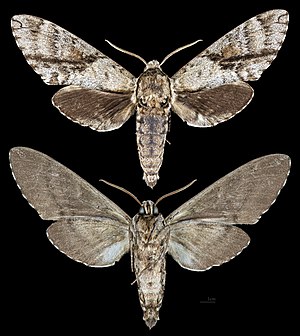Manduca jasmine arum
| Manduca jasmine arum | ||||||||||||
|---|---|---|---|---|---|---|---|---|---|---|---|---|

Manduca jasmine arum (preparation) |
||||||||||||
| Systematics | ||||||||||||
|
||||||||||||
| Scientific name | ||||||||||||
| Manduca jasmine arum | ||||||||||||
| ( Guérin , 1832) |
Manduca jasminearum is a butterfly ( moth ) fromthe swarm family (Sphingidae).
features
The moths have a fore wing length of 40 to 50 millimeters. They are not very variable in their coloring. The species has gray to gray-brown spotted and white patterned forewings and dark, only slightly drawn hind wings and is therefore easy to confuse with Ceratomia undulosa . However, it differs from the similar species in that the base color is lighter in gray and has a more receding discal spot. It also lacks the postmedial band that leads to the tip of the forewing in the similar species. The species can also be confused with Manduca brontes in North America . Manduca jasminearum , however, is much smaller and lacks the strong black pattern on the anal angle of the hind wings. In addition, Manduca jasminearum has a pair of broad, black lines that run horizontally on the forewings . The moths have a brown spot around the cell of the forewings.
In the fourth instar, the caterpillars have a blue-green basic color and are heavily bristled with secondary bristles. In the last stage they are bright light green and the bristles take on a creamy color. Her face has a pair of vertical white stripes. They have seven diagonal side strips on the body. The first six, less well developed, are cream-colored, the seventh strong one is broad and white. It extends to the anal horn . This is green, has a very grainy structure and a reddish tip.
The doll is dark maroon. Unlike most other species of the genus Manduca is proboscis with only two to three millimeters short. It is also only slightly separated from the body. The short, wide, strongly grainy structure of the cremaster is black and ends in a double point.
Occurrence
The species is common in North America. It occurs on the Atlantic coast from southern New England to northern Florida. To the west, the distribution area extends into the Appalachians and the valleys of the Ohio River and the Mississippi River to the edge of the Great Plains . In the Midwest it is proven north to Cass County (Michigan) . In the south there is also evidence in east Texas.
Manduca jasminearum inhabits forests, prefers densely vegetated areas. Presumably, the species was pushed back by human influences, especially in the northeastern United States.
Way of life
Little is known about the moths' way of life. So far they have not been detected when visiting flowers and are only known from light catches.
Flight and caterpillar times
The species flies in summer, with a generation being trained in the Appalachians. In Louisiana and Florida, they are believed to be found in two generations from May to August.
Food of the caterpillars
The caterpillars have been found on ash trees ( Fraxinus ), but they are also said to feed on lilacs ( Syringa ) and elms ( Ulmus ).
development
The females lay their eggs one by one on the underside of the leaves of the host plants. The caterpillars are solitary and eat freely on the upper side of the leaves during the day. In resting phases you can find them on the underside of the leaf on the midrib. Pupation takes place in a chamber in the ground.
supporting documents
Individual evidence
- ↑ a b c d e f g James P. Tuttle: The Hawkmoths of North America, A Natural History Study of the Sphingidae of the United States and Canada. The Wedge Entomological Research Foundation, Washington, DC 2007, ISBN 978-0-9796633-0-7 .
- ↑ a b c d Sphingidae of the Americas. Bill Oehlke, accessed December 28, 2011 .
literature
- James P. Tuttle: The Hawkmoths of North America, A Natural History Study of the Sphingidae of the United States and Canada. The Wedge Entomological Research Foundation, Washington, DC 2007, ISBN 978-0-9796633-0-7 .